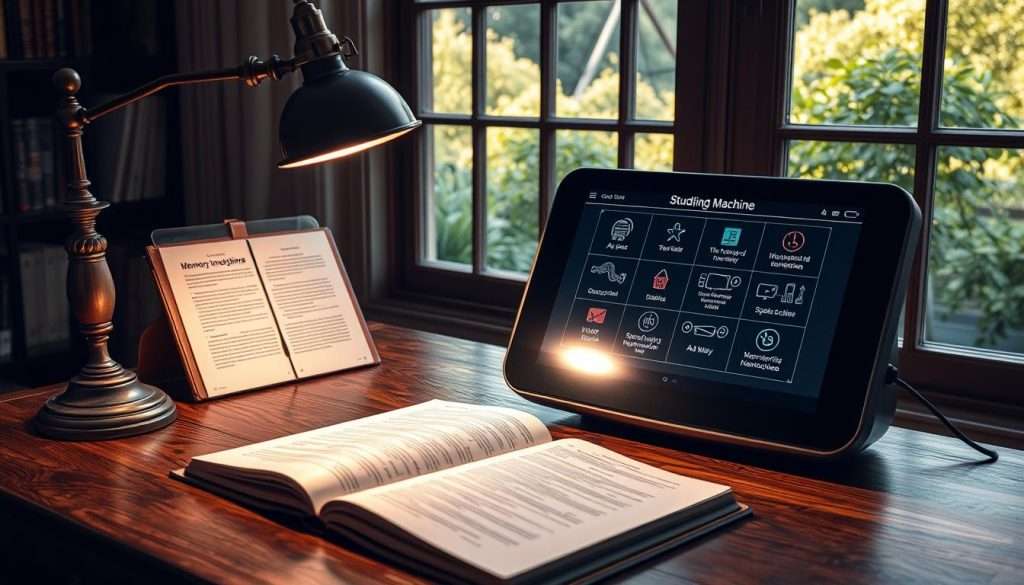We’ve all been there – stuck in a sea of information, trying to memorize anything for an exam or a presentation. But what if you could learn quickly and retain information with ease? Understanding how memory works is key to unlocking effective memorization techniques.
Traditional study methods often fall short because they don’t tap into how our brains process information. By using techniques like visualization and association, you can significantly improve your ability to memorize. These methods work by creating connections between new information and your existing knowledge, making it easier to recall when needed.
Key Takeaways
- Understanding how memory works is crucial for effective memorization.
- Techniques like visualization and association can improve memory.
- Traditional study methods often fail because they don’t align with how our brains process information.
- Creating connections between new and existing information aids recall.
- Effective memorization techniques can make learning quicker and more efficient.
The Science of Memory: Understanding How We Remember
To improve memory, we need to know how it works. Memory isn’t just remembering facts. It’s a complex process involving many stages and brain areas.
How Memory Formation Works in the Brain
Memory formation has three main steps: encoding, storing, and retrieving. Encoding is the first step where we process and understand information.
Encoding, Storage, and Retrieval Processes
After encoding, we store the information in our memory. This can be either short-term or long-term, based on how we keep it. Retrieval is the last step, where we bring back the stored information.
The Role of Neuroplasticity
Neuroplasticity is key in memory formation. It lets our brain change and strengthen connections between neurons. This boosts memory retention.
Short-term vs. Long-term Memory
It’s important to know the difference between short-term and long-term memory. Short-term memory holds info briefly, while long-term memory keeps it longer. Using repetition can move info from short-term to long-term memory.
The Forgetting Curve and How to Combat It
The forgetting curve shows how memory fades over time. To fight this, spaced repetition helps. Reviewing material at longer intervals improves retention.
Why Traditional Study Methods Often Fail
Traditional study methods often don’t give us the results we want. We’ve been taught that re-reading, highlighting, and cramming are good ways to learn. But, these methods are ineffective for long-term retention.
The Pitfalls of Passive Learning
Passive learning is a big problem with traditional studying. When we’re not actively learning, our brains tend to wander. This means we miss out on chances to really learn. So, how can we make learning more engaging? By using rapid memorization methods and interactive techniques, we can make studying fun and effective.
The Illusion of Knowledge
Traditional study methods can make us think we know more than we do. We might feel like we get it when we re-read, but forget it later. To avoid this, we need to focus on quick learning tips that help us remember better.
Why Cramming Doesn’t Work Long-term
Cramming is a classic example of a study method that fails. It might help us pass a test, but we don’t keep the info. Instead, we should use learn fast techniques like spaced repetition and active recall to keep info in our memory.
Preparing Your Mind for Optimal Memory Performance
Getting your mind ready is key for top memory skills. To enhance memory retention and boost memory recall, you need to set up your brain for success.
The Role of Sleep in Memory Consolidation
Sleep is vital for turning short-term memories into long-term ones. It’s when your brain strengthens connections between neurons. This makes remembering things easier later on.
Optimal Sleep Patterns for Learning
To improve learning speed, aim for 7-9 hours of sleep each night. A regular sleep schedule helps your brain better absorb and keep new info.
Nutrition and Supplements for Brain Health
Eating well is crucial for brain health. Focus on fruits, veggies, whole grains, and lean proteins. Omega-3s and antioxidants are especially good for your memory.
| Nutrient | Food Sources | Benefits for Memory |
|---|---|---|
| Omega-3 Fatty Acids | Salmon, Walnuts, Chia Seeds | Supports brain cell structure and function |
| Antioxidants | Blueberries, Spinach, Dark Chocolate | Protects against oxidative stress and inflammation |
Physical Exercise and Its Impact on Memory
Exercise is great for your heart and brain. It boosts blood flow to the brain, helping it make new connections.
Stress Management for Better Recall
Too much stress can hurt your memory. Try meditation, deep breathing, or yoga to reduce stress and improve recall.
The Memory Palace Technique: Spatial Memory Mastery
Discover the power of spatial memory with the memory palace technique. It’s a game-changer for anyone wanting to memorize anything fast. This ancient method uses your brain’s ability to remember places and link them to memories.
Creating Your First Memory Palace
First, pick a place you know well. It could be your childhood home, your current apartment, or a favorite walk.
Choosing Familiar Locations
Choose a place you know well. This makes it easier to navigate in your mind. Pick a location you can easily remember.
Mapping Your Route
After picking your location, map out a route through it. Make sure the route is consistent. This helps organize your memories well.
Populating Your Palace with Memorable Images
Now, fill your memory palace with memorable images. Link the information you want to remember to specific spots on your route.
Practical Applications for Memory Palaces
The memory palace technique is very useful. You can use it to memorize speeches or learn complex concepts.
Memorizing Speeches and Presentations
Link key points of your speech or presentation to spots in your memory palace. This way, you can deliver your lines confidently without memorizing.
Learning Complex Concepts
Break down complex information into simple, memorable images. Link these images to spots in your palace. This makes recalling detailed information easier.
Mastering the memory palace technique boosts your ability to memorize and recall information. It’s a valuable tool for improving your memory.
Mnemonic Devices: Memory Shortcuts That Work
Learn how to memorize anything quickly with proven mnemonic techniques. Mnemonic devices are clever tools that help you link new information to something you already know. This makes it easier to remember later.
Acronyms and Acrostics for Quick Memorization
Acronyms and acrostics are great mnemonic devices. They make information easier to remember. For example, “ROY G BIV” stands for the colors of the rainbow: Red, Orange, Yellow, Green, Blue, Indigo, Violet.
To create an acronym, take the first letter of each item you want to remember and form a word or phrase. Acrostics work similarly, but instead of forming a word, you create a sentence. Each word in the sentence corresponds to the first letter of the items you’re trying to remember.
The Name-Face Association Technique
Remembering names and faces can be tough, but the name-face association technique helps. The trick is to link the person’s name with their face and create a memorable connection.
Creating Visual Hooks for Names
To use this technique, repeat the person’s name when you meet them. Look for distinctive features on their face and link these with their name. For example, if someone’s name is “Rose” and she has a rose tattoo, you’ve got a great visual hook!
Creating Stories to Link Unrelated Information
Storytelling is a powerful way to connect unrelated information. By creating a narrative that includes the information you want to remember, you can improve your recall.
Rhymes and Songs as Memory Aids
Rhymes and songs are catchy and memorable. Using rhymes or melodies to encode information can make it stick in your memory. Think of how easily you remember song lyrics or nursery rhymes from childhood!
| Mnemonic Device | Description | Example |
|---|---|---|
| Acronyms | Form a word from the first letters of items | ROY G BIV for rainbow colors |
| Acrostics | Create a sentence from the first letters | “Every Good Boy Does Fine” for musical notes |
| Name-Face Association | Link a person’s name with their face | Associating “Rose” with a rose tattoo |
By using these mnemonic devices in your daily life, you’ll learn faster and remember better. Try different techniques to find what works best for you!
How to Memorize Anything Fast: The Proven System
We’ve found that rapid memorization comes from using proven methods and strategies. By adding these techniques to your daily life, you can memorize anything fast. You’ll also keep information better.
The Chunking Method for Breaking Down Complex Information
The chunking method is a top way to accelerate memorization. It breaks down hard information into smaller bits. This makes it simpler to remember and hold onto.
For instance, to remember a long phone number, split it into smaller groups of numbers.

Active Recall: Testing Yourself for Stronger Memories
Active recall boosts your memory. Instead of just reading over info, test yourself by trying to recall it. This makes your memory stronger and helps you remember better.
- Create flashcards to test your knowledge
- Take practice quizzes to reinforce learning
- Engage in activities that challenge your memory
Spaced Repetition: Timing Your Review Sessions
Spaced repetition reviews info at longer intervals to lock it in your memory. By timing your reviews right, you can enhance memory retention. This stops the forgetting curve in its tracks.
Creating an Optimal Review Schedule
To make spaced repetition work best, plan out your review schedule. Start with short intervals, then make them longer. For example, review info once a day, then a week later, and finally after a month.
Visualization Techniques for Enhanced Retention
Visualization is a strong tool for memorization. By linking info to vivid mental images, you make it stickier and easier to recall. Try to create mental pictures that are memorable and tie in with the info you’re trying to remember.
Memorizing Numbers and Dates Effectively
Numbers and dates are all around us. Being able to recall them well can really boost your memory. Whether you’re a student, a professional, or just want to improve your memory, learning to remember numbers and dates is very helpful.
The Major System for Converting Numbers to Images
The Major System is a great way to turn numbers into images you can remember. It works by linking consonant sounds to numbers and then making words or phrases from these sounds. For instance, the number 1 might sound like “t” or “d,” and 2 like “n.” By making a story or image that connects these sounds, you can remember complex numbers easily.
Creating Your Personal Number-Image Associations
To use the Major System well, you need to make your own connections between numbers and images. Begin by linking sounds to numbers and then practice making words or phrases from these sounds. The more unusual or personal your image, the better it will stay in your memory.
Memorizing Long Sequences of Digits
It can be tough to remember long sequences of digits, like phone numbers or PIN codes. One good way is to break them down into smaller parts, making them easier to recall. You can also use the Major System to turn these numbers into images or stories you can remember.
Techniques for Historical Dates and Timelines
For remembering historical dates and timelines, making a mental map or timeline helps a lot. Link important events to specific dates and picture them in order. Using mnemonics or making stories that connect these dates can also help you remember better.
Remembering Mathematical Formulas and Equations
Math formulas and equations can be memorized by understanding the basics and making visual connections. Break down complex formulas into simpler parts, and use mnemonics or acronyms to remember key parts.
By using these methods, you can greatly improve your ability to remember numbers and dates. This will make your memory and thinking skills better overall.
Language Learning: Vocabulary and Grammar Memorization
Learning new vocabulary and grammar rules is key in language learning. We’ll share some effective strategies to help you succeed. It’s not just about knowing the rules, but also remembering them quickly.
Word Association Techniques
Word association is a great way to memorize vocabulary. By linking new words to something familiar, you can boost your memory recall. For example, linking a new word to a personal experience or a similar word in your native language can help you remember it better.
Using Context for Better Retention
Learning words in context, not just as lists, can improve your learning speed. When you learn a word in a sentence or story, you’re more likely to remember it. This is because you’ve created a mental image or scenario linked to the word.

Memory-Friendly Approaches to Grammar Rules
Grammar rules can be tricky, but there are ways to make them stick. Using mnemonics or visual aids can help. For example, making a chart for verb conjugations is a quick learning tip.
Immersion Techniques That Strengthen Memory
Immersion is a powerful way to learn a language. Surrounding yourself with the language through media like TV, movies, music, and books can help. This method not only improves your understanding but also boosts your ability to recall language naturally.
| Technique | Description | Benefit |
|---|---|---|
| Word Association | Linking new words to known words or experiences | Improved vocabulary retention |
| Contextual Learning | Learning words within sentences or stories | Better understanding and recall |
| Grammar Mnemonics | Using memory aids for grammar rules | Easier grammar retention |
Overcoming Common Memory Obstacles
Improving your memory is not just about learning new tricks. It’s also about beating common challenges. We’ll look at these obstacles and share ways to boost your memory and reach your learning goals.
Dealing with Information Overload
In today’s world, we face a lot of data. To handle this, try the chunking method. It breaks down big info into smaller bits. This makes it easier to organize and remember.
- Identify key information
- Group similar data together
- Use headings and categories
Strategies for Difficult-to-Memorize Content
Some info is tough to remember. For this, creating stories or associations works well. Link new info to something you already know or find interesting. This makes it easier to recall.
“Association is a powerful tool in memory. By creating vivid mental images, we can link new information to our existing knowledge, making it easier to remember.”
Maintaining Focus During Learning Sessions
Staying focused is key for learning well. Try the Pomodoro Technique. It involves working in 25-minute blocks, then taking a 5-minute break. This keeps you focused and avoids burnout.
Recovering Forgotten Information
It’s normal to forget things over time. To get back forgotten info, use spaced repetition. Review material at longer intervals to strengthen your memory and make recall easier.
To memorize anything fast, mix these strategies with regular practice and review. Understanding and tackling common memory hurdles can greatly improve your learning and retention abilities.
Memorizing for Tests and Exams: Strategic Approaches
To do well in exams, knowing quick learning tips is key. Mastering the art of memorizing for tests and exams is possible with the right strategies. We’ll look at how to make study materials that help your memory, manage your time well, and remember information when it counts.
Creating Memory-Friendly Study Materials
Creating study materials that help your memory is a great way to prepare for exams. Techniques like mind mapping and flashcards are very effective.
Mind Mapping for Visual Learners
Mind mapping is a visual method that organizes information in a memorable way. It helps you boost memory recall and see how different pieces of information are connected.
Flashcards are a simple yet effective tool for memorization. They break down information into key terms and definitions. This way, you can quiz yourself and strengthen your learning.
Time Management for Optimal Memory Retention
Good time management is key when studying for exams. Spacing out your study sessions and using spaced repetition can help you remember better over time.
Techniques for Recalling Information Under Pressure
Recalling information during exams can be tough. But, there are ways to make it easier. One method is to fight test anxiety.
Combating Test Anxiety
Test anxiety can really hurt your ability to recall information. By practicing relaxation techniques and boosting your confidence, you can learn fast techniques to handle your nerves and do your best.
By using these strategies in your study routine, you can improve your memory recall and do well in exams.
Conclusion: Building a Lifelong Memory Practice
We’ve looked at many ways to improve your memory. You’ve learned how to remember things quickly and learn faster. Now, it’s time to use these techniques.
Being consistent is crucial for a strong memory. Make these practices a regular part of your life. This will help you a lot, whether you’re in school or always learning new things.
So, start your memory practice today! With hard work and the right methods, you can see amazing results. You’ll learn faster, feel more confident, and reach your full potential.

